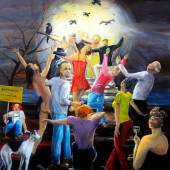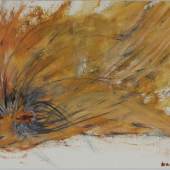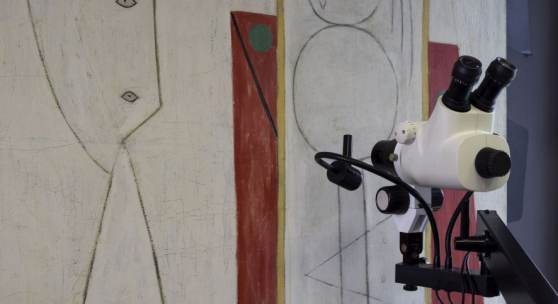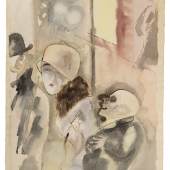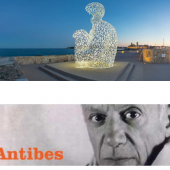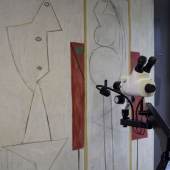Venice
L’Atelier Picasso: Peggy Guggenheim Collection and the restoration project of The Studio
-
Presse13.05.2016
Venice, May 2016 – Following the scientific examination and conservation carried out in 2015 on Jackson Pollock’s masterpiece Alchemy (1947), the conservation department of the Peggy Guggenheim Collection, Venice, has initiated an important project on another major painting in the museum, The Studio (L’Atelier) (1928) by Pablo Picasso. This is made possible by the generous support of BSI Bank, Institutional Patron of the Peggy Guggenheim Collection since 2001.
Robert Motherwell, among America’s most important post war artists, who first encountered Picasso’s painting in Peggy Guggenheim’s New York museum/gallery Art of This Century, recalled that it was: “perhaps the most important influence on my life in those first ten years in New York. That incredible white . . . The painting was surely one of the most austere and powerful works since the height of Cubism . . . unquestionably one of the masterpieces of the 20th century.” Today that white has lost its brilliancy, owing to an efflorescence of wax on its surface, a result of conservation carried out in the late 1960s when the painting was relined using wax and resin to lay down areas of lifting paint. In addition, deposits of atmospheric particles have dimmed the colors impeding a correct reading of the painting’s chromatic intensity and composition. In April examination of the work by the Peggy Guggenheim Collection conservation department was initiated in order to understand Picasso’s technique – studies necessary also to establish the correct procedures and the appropriate materials for selectively and gradually removing the unwanted surface accretions.
After completing The Studio in 1928, Picasso reworked the painting, reducing its color palette and simplifying its compositional complexity, overpainting forms and colors with a fresh layer of white, before entrusting the painting to his legendary art dealer Daniel H. Kahnweiler. Six years later, in 1934, Picasso exchanged it with Kahnweiler for five others, evidence of the special importance Picasso attributed to this work. At the start of World War II The Studio was lent to Alfred H. Barr Jr.’s seminal exhibition Picasso: Forty Years of His Art at the Museum of Modern Art. In 1942 Picasso consigned the painting to New York dealer Valentine Dudensing from whom Peggy Guggenheim, at the suggestion of her husband Max Ernst, acquired that year, shortly before opening her Art of This Century.
In 1983 the Metropolitan Museum of Art, New York, and subsequently in 1996 in Venice, The Studio underwent a series of examinations with the purpose of discovering Picasso’s first, underlying image, that of 1928. At that time, X-rays, infra-red reflectography, UV fluorescence, and visible eye examination made possible only a speculative reconstruction. Today, major advances in research tools and scientific instrumentation make it possible to retrieve a more detailed image of the first version of the painting. In the next months The Studio will therefore undergo thorough investigation by the technicians of the mobile research laboratory MOLAB of CNR-ISTM from Perugia, in order to understand the creative process of one of the major paintings of the 20th century.
The research project will benefit from the collaboration of, among others, the Consorzio universitario CSGI-University of Florence, in the context of the European project NANORESTART (NANOmaterials for the REStoration of works of ART) financed by the European Commission. One of the objectives of this project, in which the Peggy Guggenheim Collection is a participant, is that of developing new nano-materials for the selective cleaning of works of modern and contemporary art. These materials are designed not to leave any residue on the work of art, and are non-toxic and ecologically compatible, making this one of the most advanced and sophisticated techniques available to the conservation field.
Examination and research will be coordinated by the Peggy Guggenheim Collection Conservation Department in association with the Conservation Department of the Solomon R. Guggenheim Museum, New York. Conservation will be conducted by the conservator of the Peggy Guggenheim Collection, under the supervision of the Soprintendenza belle arti e paesaggio of Venice.
Since 2001 BSI Bank, to which a display room is dedicated inside the museum, is an Institutional Patron of Peggy Guggenheim Collection. This commitment is part of the bank's ongoing support to the cultural, economic and scientific development of the communities it serves, and gives to BSI the opportunity to take an active role in the contemporary dialogue between business and culture, helping to sustain the museum’s growth and programming. Besides to partner a major institution like Guggenheim Collection in Venice, BSI’s passion for art finds its roots in the bank itself, which in the year 2000 created its own contemporary art collection - today among the 100 most prestigious corporate art collections worldwide.
-
27.03.2021 - 05.04.2021Bedauerlicherweise sind auch wir als Veranstalter der ART&ANTIQUE Residenz Salzburg vom...
-
Der Kunstmarkt der vergangenen Jahre war von einem steigenden Interesse an Werken...
-
13.05.2016Presse »
Opening hours
Daily 10 am - 6 pm
Closed Tuesdays and December 25Tickets
Adults: €14
Senior visitors over 65 yrs.: €12




